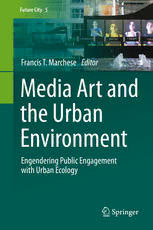
Media Art and the Urban Environment: Engendering Public Engagement with Urban Ecology PDF
Preview Media Art and the Urban Environment: Engendering Public Engagement with Urban Ecology
Future City 5 Francis T. Marchese Editor Media Art and the Urban Environment Engendering Public Engagement with Urban Ecology Media Art and the Urban Environment FUTURE CITY Volume 5 AdvisoryBoard JackAhern,UniversityofMassachusetts,DepartmentofLandscapeArchitectureandRegional Planning,Amherst,MA,USA JohnBolte,OregonStateUniversity,Biological&EcologicalEngineeringDepartment, Corvallis,OR,USA RichardDawson,UniversityofNewcastleuponTyne,SchoolofCivilEngineering& Geosciences,NewcastleuponTyne,UK PatrickDevine-Wright,UniversityofManchester,SchoolofEnvironmentandDevelopment, ManchesterSchoolofArchitecture,Manchester,UK AlmoFarina,UniversityofUrbino,InstituteofBiomathematics,FacultyofEnvironmental Sciences,Urbino,Italy RaymondJamesGreen,UniversityofMelbourne,FacultyofArchitecture,Building&Planning, Parkville,VIC,Australia GlennR.Guntenspergen,NationalResourcesResearchInstitute,USGeologicalSurvey,Duluth, MN,USA DagmarHaase,HelmholtzCentreforEnvironmentalResearchGmbH–UFZ,Departmentof ComputationalLandscapeEcology,Leipzig,Germany MichaelJenks,OxfordBrookesUniversity,OxfordInstituteofSustainableDevelopment, DepartmentofArchitecture,Oxford,UK CecilKonijnendijkvandenBosch,SwedishUniversityofAgriculturalSciences,Departmentof LandscapeArchitecture,PlanningandManagement,Alnarp,Sweden JoanIversonNassauer,UniversityofMichigan,SchoolofNaturalResourcesandEnvironment, LandscapeEcology,PerceptionandDesignLab,AnnArbor,MI,USA StephanPauleit,TechnicalUniversityofMunich(TUM),ChairforStrategicLandscapePlanning andManagement,Freising,Germany StewardT.A.Pickett,CaryInstituteofEcosystemStudies,Millbrook,NY,USA RobertVale,VictoriaUniversityofWellington,SchoolofArchitectureandDesign,Wellington, NewZealand KenYeang,LlewelynDaviesYeang,London,UK MakotoYokohari,UniversityofTokyo,GraduateSchoolofSciences,InstituteofEnvironmental Studies,DepartmentofNaturalEnvironment,Kashiwa,Chiba,Japan FutureCityDescription Asof2008,forthefirsttimeinhumanhistory,halfoftheworld’spopulationnowliveincities. Andwithconcernsaboutissuessuchasclimatechange,energysupplyandenvironmentalhealth receivingincreasingpoliticalattention,interestinthesustainabledevelopmentofourfuturecities hasgrowndramatically. Yetdespiteawealthofliteratureongreenarchitecture,evidence-baseddesignandsustainable planning,onlyafractionofthecurrentliteraturesuccessfullyintegratesthenecessarytheoryand practicefromacrossthefullrangeofrelevantdisciplines. Springer’sFutureCityseriescombinesexpertisefromdesigners,andfromnaturalandsocial scientists, to discuss the wide range of issues facing the architects, planners, developers and inhabitantsoftheworld’sfuturecities.Itsaimistoencouragetheintegrationofecologicaltheory intotheaesthetic,socialandpracticalrealitiesofcontemporaryurbandevelopment. Moreinformationaboutthisseriesathttp://www.springer.com/series/8178 Francis T. Marchese Editor Media Art and the Urban Environment Engendering Public Engagement with Urban Ecology 123 Editor FrancisT.Marchese DepartmentofComputerScience PaceUniversity NewYork,NY,USA ISSN1876-0899 ISSN1876-0880 (electronic) FutureCity ISBN978-3-319-15152-6 ISBN978-3-319-15153-3 (eBook) DOI10.1007/978-3-319-15153-3 LibraryofCongressControlNumber:2015936191 SpringerChamHeidelbergNewYorkDordrechtLondon ©SpringerInternationalPublishingSwitzerland2015 Thisworkissubjecttocopyright.AllrightsarereservedbythePublisher,whetherthewholeorpartof thematerialisconcerned,specificallytherightsoftranslation,reprinting,reuseofillustrations,recitation, broadcasting,reproductiononmicrofilmsorinanyotherphysicalway,andtransmissionorinformation storageandretrieval,electronicadaptation,computersoftware,orbysimilarordissimilarmethodology nowknownorhereafterdeveloped. Theuseofgeneraldescriptivenames,registerednames,trademarks,servicemarks,etc.inthispublication doesnotimply,evenintheabsenceofaspecificstatement,thatsuchnamesareexemptfromtherelevant protectivelawsandregulationsandthereforefreeforgeneraluse. Thepublisher,theauthorsandtheeditorsaresafetoassumethattheadviceandinformationinthisbook arebelievedtobetrueandaccurateatthedateofpublication.Neitherthepublishernortheauthorsor theeditorsgiveawarranty,expressorimplied,withrespecttothematerialcontainedhereinorforany errorsoromissionsthatmayhavebeenmade. Coverimagecredits:KeithDeverell(left)andJoshHillPhotography(right) Printedonacid-freepaper SpringerInternational PublishingAGSwitzerlandispartofSpringerScience+Business Media(www. springer.com) Preface Morethanhalftheresidentsoftheglobenowliveincities,andmuststrivetoflourish indenselycrowdedurbanenvironmentscharacterizedbyinequality,socialconflict andenormouspotentialforgrowthandchange.Newmediaartistsworkinginurban settings are stimulating awareness, altering our perceptions of, and relationships with, urbanspace thoughtheir digital inventionsand interventions.These innova- tionscan be used in the developmentof futurepracticesforhelpingresidents,not onlycopewiththedailychallengescreatedbyurbanenvironment,butalsoflourish despite the inequality, spatial density, social conflict, and disorganization that are symptomaticofcities. The purpose of this book is to formally appraise the ways new media artists engage urban ecology. It gathers together essays from artists, architects, urban planners,andcriticaltheoriststoconsiderthesenewmodesofseeing,representing, and connecting within the urban setting. What makes this book unique is that it spotlightsartistsinsteadoftechnologistsasinnovatorsandagentsoftechnological change.Because these individualscreate socially motivatedartwork, they possess a clear understanding of the societal issues and values they wish to address. And because these artists know how to exploit state-of-the-art technology, they can create artworks that transcend the technology’s original purpose, thus expanding thelanguageofenvironmentalengagement. For the purpose of this volume urban ecology may be defined in a two- fold way.1 From the natural science perspective, urban ecology investigates the biological structures and environmental processes that support them in urban spaces. Here, urban ecology focuses on plant populations, animal communities, andenvironmentaleffects,includinghuman,onthem.Acomplementarydefinition takes an anthropocentric view where humans are at its center. The field of urban 1Endlicher, Wilfried, Marcel Langner, Markus Hesse, Harald A. Mieg, Ingo Kowarik, Patrick Hostert,ElmarKulkeetal.“UrbanEcology-DefinitionsandConcepts.”ShrinkingCities:Effects onUrbanEcologyandChallengesonUrbanDevelopment(2007):1–13. v vi Preface ecology then expands its emphasis to the improvement of living conditions for human residents as part of an augmented characterization of an ecosystem that includestheoriesfromsocialandplanningsciences. This volumeis composedof14 chaptersdistributedacrossthree generalareas: urbanecologyand its engagement,reimaginingandtransformingthe city,andthe viewfromthestreets. In the first chapter, “Toward an Ecological Urbanism: Public Engagement in ContemporaryArtPractice,”MariaMichailssurveysadiversityofartistsworking within the urban environment, considering artworks and projects designed to inspire community awareness and stewardship of urban ecological systems. In Chap. 2, “ExploringEnvironmentalStewardship ThroughData-DrivenPractices,” Tega Brain and Jodi Newcombe expand on Michails survey by exploring the strategiesthatartistsanddesignersemploytoengageurbanaudiences.Inparticular, they assess how data from smart cities may be used to create artworks that can recastresidents’understandingofurbanspace.GrishaColemanaandDaraghByrne followwithadiscussionofhowarts-drivenprocessescanbeusedtobridgeartistic practice and research in “Experiential Ecologies: A Transdisciplinary Framework for Embodiment and Simulacra,” by considering how varied forms of ecological informationcanbecombinedtocreatefoundationsforexhibition,engagementand performance. These chapters are complemented by two chapters in which artists discusstheirwork.InChap.4,“Uncultivated:anEvolutionaryDramaintheUrban Environment,”LynnCazabonexploreshowherpublicartprojectdocumentingwild plants in urban landscapes with geo-referenced photographs and public displays increases awareness of overlooked plant life. In “Alone Together in the Dark: Horror Based Artworks and Fan Participation in Urban and Extra-Urban Space,” Jillian McDonald recounts several projects in which the performances of horror fans in urban and ruralstimulates new awarenessof, and conversationsabout,the environmentandsociety. Urban information,its representation,perception, and use are importantissues inthetransformationofurbanecology.InChap.6,“MobileMapsofChamaleonic Cities:UrbanCartographiesandMethodologicalProceduresandExperiences,”by PedroMarraandCarmenArozteguiMassera,explorehowtemporalityandspatiality are constructed in contemporary cities. By investigating the flow of capital, the staging of mega urban events such as Brazil’s World Cup, and the use of artistic interventions, they propose methods for better understanding urban mobility and enabling greater residential participation in its evolution. Alice Arnold follows in Chap. 7 with “Electric Signs,” a discussion of the background behind her documentaryfilmofthesamename.Atitscore,thechapterconsidersurbanspace, the transformationof the ecologicaldynamicsof majorinternationalcities though corporateinstallationoflargeLEDdisplays,andthesocio-politicalramificationsof thesetransformations.Thetransformationofurbanspace isreflecteduponaswell in Chap. 8 by Annette Weintraub. “Overload/Absence: The Collapse of Space to Surface in Representations of Urban Space” considers the rapid diminishment of urbanpublic space throughgentrificationand privatization,and its transformation through mediazation. By comparing hyperactive urban media zones with the Preface vii numbinglyblandfaçadesofcontemporaryurbanarchitecture,Weintraubelucidates the perceptual shift from urban space to surface, and explores how surfaces have been utilized to generate new representations of urban space. In “Design as Topology:U-City,” Ulrik Ekman further exploresthe dynamic transformationsof urban space by discussing the design of a busy traffic intersection in the South Korean u-city (ubiquitouscity) Songdo as a topological problem. The emergence of u-cities or smart cities creates challenges and opportunities for an emergent, mobile,andgloballyconnectedcitizenry,andthetechnologicalsubstratethatmust bedevelopedtosupportit.Withafocusonthenatureofasingletrafficintersection, Ekmanferretsoutthelayersofdesignissuesanticipatedtosupportthedynamicflow of information and flow of people, focusing on a critical comparative discussion of a variety of ontologicaland epistemological approachesto design as topology, includingculturaltheory and technicalstudies. In Chap.10, “The EmergentCity: 2004–2012,” the artist Stanza complements Ekman’s presentation by discussing howhisvisualartworksareinformedbycriticalanalysisofcityspaces.Asanartist who designsurbanexperimentsand gathersdata throughnetworksof sensors and videocameras,hecapturesthedynamicpatternsofurbandwellersandre-imagines themasinformationvisualizations. The remaining four chapters consider street art and its ability to engage urban residents. Francis Marchese’s chapter, “The Art of Urban Engagement,” reviews how digital media artists have exploited pervasive technologies to explore urban ecology. By their interventions, they challenge a city’s inhabitants to reconsider theirdailyurbanexperiences.VaughnWhitneyGarlanddiscusseshownewonline communitycollaborationstransformurbansitesintospacesfornewartinChap.12, “OurPlaceonThatWall:CommunityOnlineArtProjects.”Inparticular,hefocuses on the nature of online community art projects as works orchestrated by artists exercising the interconnected and participatory nature of the Internet. Brian A. Brown argues in “Digitized Street Art,” that ‘street art’ is an ephemeral means of artistic expression dependent upon the whim of the urban environment for its display,andreliesondigitaltechnologiesforitsdocumentationanddissemination, thus transforming urban street artists into digital artists. Finally, the artist Malin Abrahamssonconsidersher temporarypublic art installation, “Solar Cycle 24: 15 NightlyProjections,”whichemphasizesplace-makinganddigitalaestheticsinthe urban environment. Installed in a storefront, the vibrant, projected visualizations engaged New York City residents through a simulation of the aurora borealis, a phenomenonvisiblearoundtheNorthandSouthPoles. NewYork,NY,USA FrancisT.Marchese Acknowledgements I am extremelygratefulto have had the opportunityto workwith the contributors tothisvolumethroughoutitspreparation.Theirinsights,energy,andcreativityhave contributedtothecreationofabookwhichIhopereaderswillfindbothstimulating andthoughtful.IwouldalsoliketothanktheeditorsatSpringer-Verlag,especially SimonReesandWayneWheeler,fortheirsupportofthisproject. ix
